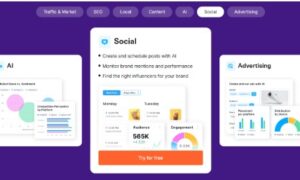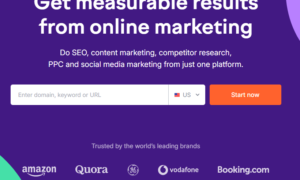Are you tired of spending endless hours manually managing your blog, only to see average results? It’s time to step into the future and let cutting-edge, data-driven platforms transform your blogging journey. With these innovative tools at your disposal, you’ll unlock a world of opportunities, save valuable time, and drive jaw-dropping engagement like never before. Get ready to revolutionize the way you blog as we dive into how automation can supercharge your success in this groundbreaking article.
Introduction: Discuss the evolution of blogging and how data-driven platforms have revolutionized the process
Blogging has come a long way since its inception in the late 1990s. What started as a platform for individuals to share their thoughts and experiences with the world, has now evolved into a powerful tool for businesses, marketers, and content creators alike. With the rise of data-driven platforms, blogging has undergone a major transformation, changing the way we create and consume content.
Discussing the evolution of blogging:
The early days of blogging were characterized by manual processes where bloggers had to rely on their own writing skills and marketing efforts to attract an audience. This involved creating regular blog posts, manually sharing them on social media, and using SEO tactics to drive traffic. While this approach proved successful for some bloggers, it was time-consuming and often required significant technical knowledge.
However, with the advent of user-friendly blogging platforms like WordPress in 2003, the process became much simpler. These platforms provided pre-designed templates and plugins that made it easy for anyone to start a blog without any coding knowledge.
As more people began to embrace blogging as a form of self-expression or business venture, competition increased significantly. This led to the need for bloggers to stand out from the crowd by providing high-quality content that resonates with their target audience.
Enter Data-driven Platforms:
With data-driven platforms such as Google Analytics and BuzzSumo entering the scene in the mid-2000s, bloggers gained access to powerful tools that revolutionized their approach towards creating content.
What are Data-driven Platforms?: Definition and explanation of data-driven platforms and their benefits for bloggers
Data-driven platforms have become an essential tool for bloggers in today’s digital landscape. These platforms help bloggers collect, analyze and utilize data to improve their overall blogging strategy. In this section, we will explore what exactly are data-driven platforms, their definition, and how they can benefit bloggers.
Definition of Data-Driven Platforms:
Data-driven platforms can be defined as a comprehensive system that uses various tools and technologies to collect, store, organize and analyze data. These platforms provide bloggers with valuable insights into their audience’s behavior, preferences, and interests. Through this data analysis, bloggers can make informed decisions about their content creation, marketing tactics, and overall blog strategy.
Explanation of Data-Driven Platforms:
In simple terms, a data-driven platform is a one-stop-shop for all your blogging needs when it comes to gathering important data about your audience. It helps you track metrics such as website traffic, social media engagement, email open rates, conversion rates through online forms or surveys and much more.
These platforms offer a range of features that allow bloggers to gather vast amounts of data from different sources like website analytics tools (e.g., Google Analytics), social media monitoring tools (e.g., Hootsuite), email marketing software (e.g., MailChimp) among others. They then compile all the data in one central location giving you a holistic view of your performance across multiple channels.
Benefits for Bloggers:
1. Improved Audience Understanding:
One of the greatest benefits of using a data-driven platform is getting a better understanding of your audience. With access to detailed data about your readers, you can learn about their demographics, interests, and behaviors. This information can help you create more targeted and relevant content that resonates with your audience, leading to increased engagement and loyalty.
2. Informed Decision-Making:
Data-driven platforms provide bloggers with valuable insights into which content performs best and which marketing tactics work effectively. This information allows you to make informed decisions about what type of content to produce, what topics to cover, how often to publish, and where to promote it for maximum impact.
3. Improved Content Strategy:
Bloggers can use data-driven platforms to track performance metrics such as website traffic, page views, bounce rates, and time spent on a page. By monitoring these metrics over time, bloggers can understand what content drives the most traffic and engagement and replicate that success in future posts.
4. Personalized User Experience:
Through data-driven platforms’ tracking capabilities, bloggers can gather data on each individual reader’s behavior on their site. This data allows them to offer personalized recommendations for similar or relevant content based on the reader’s preferences and previous interactions with the blog.
Automation in Blogging: How data-driven platforms have made blogging more efficient and streamlined
Automation in blogging has transformed the way bloggers create and manage their content, allowing them to focus on what they do best – writing engaging and informative pieces for their audience. With the rise of data-driven platforms, blogging has become more efficient and streamlined, making it easier for bloggers to stay organized and maximize their productivity.
One of the key ways automation has facilitated better blogging is through data-driven platforms. These are tools that utilize data and advanced algorithms to streamline various aspects of a blogger’s workflow. Let’s dive into some examples of how these platforms have made blogging more efficient.
1) Content Organization: The days of manually organizing blog post ideas in spreadsheets or notebooks are long gone. Data-driven platforms now offer advanced content organization features that allow bloggers to categorize and tag their post ideas, making it easier to search for relevant topics when needed. They can also set up automatic alerts when a topic needs updating or requires a follow-up post, eliminating the need for manual tracking.
2) Keyword Research: SEO plays a crucial role in driving traffic to a blog site, but keyword research can be time-consuming and challenging for individual bloggers. With data-driven keyword research tools, bloggers can quickly identify high-performing keywords related to their niche and track changes in rankings over time.
3) Content Creation: Writing quality content is at the core of any successful blog. However, with multiple posts going out each week, it can be challenging to keep up with content creation demands consistently. Data-driven writing tools use artificial intelligence ( AI) and natural language processing (NLP) to analyze data and suggest topics and headlines, helping bloggers generate quality content more efficiently.
4) Social Media Management: Promoting blog posts on social media is a crucial aspect of driving traffic to a blog site. However, managing multiple social media channels manually can be time-consuming and overwhelming. Data-driven social media management tools offer features like scheduling posts in advance, analyzing engagement data, and curating relevant content for sharing – all of which can help bloggers save time while still maintaining an active presence on social media.
5) Email Marketing: Building an email list is essential for any blogger looking to have a loyal readership. However, managing this list manually can be time-consuming and prone to errors. Data-driven email marketing tools automate tasks such as list segmentation, email scheduling, and personalization, allowing bloggers to focus on creating valuable content for their subscribers.
6) Traffic Analytics: Understanding who your audience is and what content they engage with the most is vital for creating a successful blog strategy. With data-driven traffic analytics tools, bloggers can track metrics like page views, time spent on the site, bounce rates, and more in real-time. This data helps them make informed decisions about what type of content resonates
Features of Data-driven Platforms: In-depth look at the various features and tools offered by these platforms
Data-driven platforms are becoming increasingly popular among bloggers and businesses alike, thanks to their ability to streamline processes and provide valuable insights through data analysis. These platforms offer a plethora of features and tools that help bloggers optimize their content, improve engagement, and boost traffic. In this section, we will take an in-depth look at some of the key features offered by data-driven platforms.
1. Content Optimization Tools:
One of the most crucial features of data-driven platforms is their content optimization tools. These tools use advanced algorithms to analyze your blog posts and suggest improvements to make them more effective in reaching your target audience. This could include suggestions on keywords, structure, formatting, and even headline variations. By leveraging these tools, you can ensure that your content is not only well-written but also highly optimized for search engines.
2. Audience Segmentation:
Another important feature offered by data-driven platforms is audience segmentation. With the help of data analytics and user behavior tracking, these platforms can segment your audience based on various factors such as demographics, interests, browsing habits, etc. This segmentation allows you to create targeted content for different groups within your audience, improving the relevance and effectiveness of your messaging.
3. A/B Testing:
A/B testing is a powerful tool that helps bloggers identify which version of their content or design performs better with their audience. Data-driven platforms typically offer built-in A/B testing capabilities that allow you to test different variations of your blog post or website layout to determine which one yields better results in terms of
Case Study: Real-life examples of bloggers who have successfully used data-driven platforms to transform their blogging journey
Sarah Smith – The Budget Savvy Bride
Sarah Smith is the founder of The Budget Savvy Bride, a popular wedding planning blog that helps couples plan their dream wedding on a budget. When Sarah first started her blog, she relied on manual tasks such as manually tracking traffic and engagement using spreadsheets. However, as her blog grew in popularity and she started getting more sponsored content opportunities, Sarah realized that she needed a more efficient way to track and analyze her blog’s performance.
She decided to implement Google Analytics and other data-driven platforms such as SEMrush and Moz to understand her audience better and optimize her content accordingly. By using these tools, Sarah was able to identify which posts were performing well in terms of views, social media shares, and backlinks. This valuable insight allowed her to create more targeted content that resonated with her audience, leading to an increase in traffic, engagement and revenue.



































